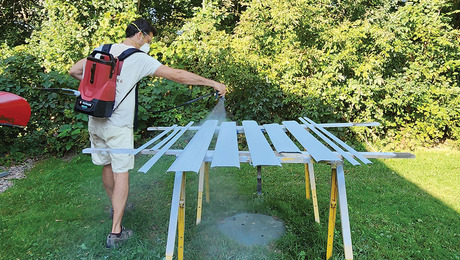
I needed to repair a crack in a chimney and wanted the color of the new mortar to match that of the existing mortar. I had heard about using acid concrete stain for this purpose, so I called the local paint store. They could mix only gallons. I started researching the idea of making my own concrete stain and found this web page on the topic: finishing.com/242/29.shtml.
From some of the conversations on the web page, I gathered that I could put two parts muriatic acid (a common cleaner for concrete and mortar) into eight parts water to make a solution for concrete-coloring pigments. Wearing rubber gloves and eye goggles, I used a glue syringe to inject 4 cc of acid into 16 cc of water. (Always add acid to water to avoid splashing acid.) After that, I just needed some pigment.
Years ago, I read a tip in Fine Homebuilding about Mixol universal tints. I bought the basic kit, which comes with a color chart showing the different hues that can be produced with the 10 concentrated pigments. The lightest shade of #23 looked exactly like what I wanted, so I put about four drops of color #23 into my 20 cc of acid/water mix and tried it on concrete in my shop. It was a little too light, but about six drops more gave me the color I needed.
If you try this, follow all the instructions on the muriatic-acid container, and be sure to do a test in an out-of-the-way place.
—Don Mathis, Macomb, IL
Edited by Charles Miller
From Fine Homebuilding #233






























View Comments
Use a plastic or glass container to mix the muriatic acid. It will react violently with metal.
I imagine this would work for parging too?
I recently added two new windows and had to reapply the parging around the windows. I was able to match up the trowel marks to the original, however the old parging is a few shades darker.
Just wanted to add that even if you think "Oh, I'll be careful, I won't splash when I add water to acid", it almost certainly will splash.
Adding water to acid creates a strong exothermic (heat generating) reaction, causing the water to violently boil and splash the concentrated acid.
However, adding acid to water forms a weak acid and the heat readily dissipates without causing the water to boil.
ALWAYS add acid to water as was stated here, (and also by your H.S. chemistry teacher).
And there you have an answer to "Will I ever need this in real life?"
Agreed! fyi: I was the guy the HS Chemistry teacher let mix all the class' chemicals.
This may not be an option in every part of the US, but you may be able to make things easier by searching for a quality local masonry supplier. At our business in Lancaster, PA, we stock 15 pre-blended mortar colors, and have another line were we have color canisters that can be mixed with cement to achieve color matches. It's not always a *perfect* match, but especially for a chimney where you won't easily see slight differences, perfect might not be necessary.
will this work for a concrete slab patch as well?
The referenced finishing.com webpage (12/21) is no longer live, but it's archived in the Internet Archive at:
Short URL:
https://bit.ly/3qpzbHO
Full URL:
https://web.archive.org/web/20170219120406/http://www.finishing.com/242/29.shtml